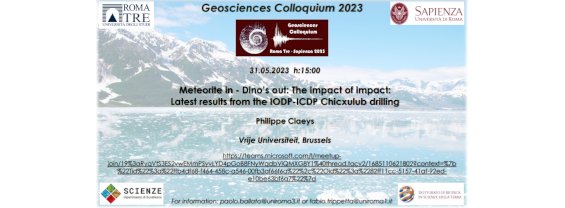Geosciences Colloquium: seminario di Philippe Claeys (Vrije Universiteit Brussels) su Teams - 31 maggio 2023 ore 15.00

Nell'ambito dei Geosciences Colloquium, la dott.ssa Nadia Lo Bue (INGV) terrà un seminario dal titolo "Meteorite in – Dino’s out: The impact of impact: Latest results from the IODP-ICDP Chicxulub drilling", mercoledì 31 maggio 2023 alle ore 15.00 su Teams.
Link Teams: https://teams.microsoft.com/...
Abstract
More than forty years ago, the detection of a positive Iridium (Ir) anomaly of several parts perbillion (ppb) at the Cretaceous-Paleogene (K-Pg) boundary in Gubbio (Italy) and Caravaca (Spain) triggered the theory that, 66 million years ago, a ± 10 km meteorite collided with Earth, inducing a major mass extinction, and the demise of the non-avian dinosaurs.
The fine (mm to cm thick) boundary clay layer is also enriched in other platinum group elements (PGE) and shows a less radiogenic value of 187Os/188Os, unmistakably supporting an extraterrestrial contribution. The PGE elemental ratio, together with Os and Cr isotope ratios constrain the nature of the impacting meteorite to a specific type of carbonaceous chondritic projectile (CMor CR). The Ir-PGE enrichment is reported at continental and marine K-Pg boundaries worldwide. In 2016, IODP-ICDP Exp. 364 recovered a ~830 m near-continuous core within the Chicxulub peak-ring containing a ~75 cm thick succession of post-impact sediments deposited on top of a ~130 m thick suevite, just below the appearance of the first Paleocene pelagic carbonates. This ‘transitional unit’, is composed of generally fining-upward, laminated dark brown to dark grayish brown carbonate-rich silty claystone to micrite. A clear positive Ir anomaly in excess of1 ppb is measured towards its very top, comparable in magnitude and pattern to other K-Pg boundary sites in the Gulf of Mexico. It is associated with a marked drop in 187Os/188Osvalues. Clearly, the ultrafine Ir-rich dust transported across the entire planet in the aftermath of the impact event also settled within the newly formed crater, placing strict and unprecedented time constraints (< 20 years) on the deposition of the transitional unit, and its underlying proximal impactite sequence.
The identification of the now world-famous Ir anomaly on top of the impactite sequence deposited within the crater conclusively ties Chicxulub to the global Ir layer and to all the K-Pg boundary sections worldwide, unequivocally connecting the Yucatan impact event to all the sedimentary sections that record the K-Pg mass extinction.

